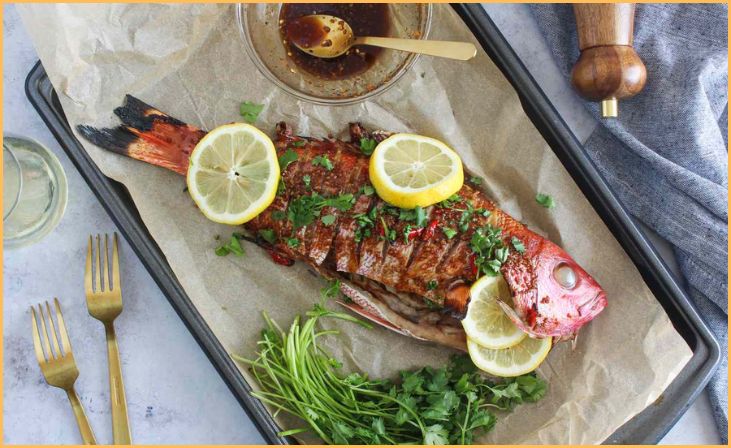Cooking fish directly from the freezer can be a time-saving and convenient option, ensuring you have a delicious meal ready without the need for advance thawing. However, cooking frozen fish requires some special considerations to achieve the best results. In this article, we’ll explore eight crucial tips that will help you cook frozen fish to perfection.
Must look At The Tips for Cooking Fish
Here are some essential tips to ensure your fish turns out perfectly every time.
Use Individual Portions for Convenience

Certainly! When freezing fish, dividing it into individual portions before freezing offers several advantages. Firstly, portioning the fish into individual fillets or pieces facilitates convenience when it comes to accessing the exact amount needed for a meal. This means you can simply take out as many portions as required without having to thaw the entire batch of frozen fish.
Additionally, this practice helps in preventing overcooking. By having fish divided into individual portions, you can cook only the amount needed for a particular meal. Thawing and cooking smaller portions of fish are more manageable and ensure that each piece is cooked to perfection without the risk of overcooking any unused portions.
Read Also: 10 Veggie Sandwiches You’ll Want to Make Forever
Prevent Thawing for Better Texture
Cooking fish straight from the freezer is a boon for texture and moisture retention. Thawing frozen fish risks losing its natural juices, resulting in a lackluster, dry outcome. When cooked from its frozen state, the fish maintains its inherent moisture, safeguarding its tenderness. This method shields the fish from the moisture loss encountered during the thawing process. Consequently, the gradual cooking process preserves the fish’s succulence, preventing dryness, and ensuring a flavorful outcome. By circumventing thawing, this approach locks in the fish’s original taste and texture, offering a convenient way to relish moist, flavorful fish without compromising its quality.
Adjust Cooking Time and Temperature
When cooking frozen fish, adjusting both time and temperature is crucial for even cooking. Lower temperatures coupled with slightly extended cooking durations ensure a balanced cook throughout. This approach prevents the outer layers from overcooking while waiting for the insides to thaw completely. Adhering to recommended cooking times, specifically tailored for frozen fish, is pivotal. It allows the fish to defrost gradually, ensuring the entire fillet or piece reaches the desired level of doneness without compromising its texture or taste. Embracing these adjustments results in perfectly cooked fish—tender, moist, and evenly prepared from its frozen state, enhancing the overall culinary experience.
Enhance Flavor and Prevent Sticking
Before seasoning frozen fish, applying a light coat of oil or melted butter is key. This step isn’t just about flavor enhancement; it serves as a protective barrier, preventing the fish from sticking to the cooking surface. The oil or butter creates a shield, ensuring a delightful crispness while cooking. This thin layer not only adds a subtle richness to the fish but also facilitates an evenly golden exterior. Embracing this preparatory step guarantees a hassle-free cooking experience, preserving the fish’s integrity and allowing for a beautifully seared, non-stick finish.
Opt for Baking or Broiling

Baking or broiling frozen fish stands out as an optimal choice. These methods excel in delivering consistent heat, guaranteeing thorough cooking from all angles. The even distribution of heat ensures that the fish cooks uniformly, preventing excessive charring while maintaining a moist, succulent interior. Both baking and broiling offer a controlled cooking environment that gently cooks the fish, preserving its tenderness and flavors. This approach not only minimizes the risk of uneven cooking but also showcases the fish’s natural taste, resulting in a delightful, perfectly cooked dish straight from the freezer.
Avoid Pan-Frying for Frozen Fish
Pan-frying frozen fish isn’t recommended due to its susceptibility to uneven cooking and moisture loss. Direct heat from pan-frying can compromise the fish’s texture and tenderness, leading to potential dryness. Although pan-frying fresh fish is a common practice, when dealing with frozen fish, it’s advisable to opt for alternative cooking methods like baking or broiling. These methods offer more controlled heat distribution, ensuring a more consistent and thorough cook, thereby preserving the fish’s moisture and tenderness. By steering clear of pan-frying frozen fish, you’ll achieve better results and maintain the fish’s quality straight from the freezer.
Use an Instant-Read Thermometer for Accuracy
Using an instant-read thermometer is key to gauging the readiness of frozen fish. Insert the thermometer into the thickest section of the fish to get an accurate internal temperature reading. When it registers at 145°F (63°C), the fish is cooked through, rendering it safe to consume. This temperature ensures that harmful bacteria are eradicated, guaranteeing the fish is fully cooked without being overdone. By relying on this method, you ascertain both safety and optimal doneness, achieving perfectly cooked frozen fish with confidence.
Read also: 3 Best Burger Smasher Tool To Choose!
Monitor Texture and Color for Doneness

A reliable way to confirm the readiness of cooked frozen fish is by checking its texture and appearance. When probed with a fork, a fully cooked fish should effortlessly flake apart. This flakiness indicates that the fish has reached the desired doneness. Additionally, inspect the fish’s color; an opaque appearance throughout signifies that it’s cooked through and ready to be enjoyed. By observing both the texture, ensuring easy flakiness, and the consistent opaque color, you ensure that your frozen fish has been perfectly prepared and is ready to savor.
Cooking fish directly from the freezer is a convenient way to prepare a quick and delicious meal. By following these eight crucial tips, you’ll be able to cook frozen fish with confidence, ensuring that it’s flavorful, moist, and perfectly cooked. Whether you’re using baking, broiling, or another method, your frozen fish can be a delightful culinary experience.
Conclusion
Cooking fish directly from the freezer requires specific techniques to ensure a delicious and well-prepared meal. The eight crucial tips for cooking frozen fish encompass essential steps like adjusting cooking times, using proper thawing methods, and employing suitable cooking techniques. By following these guidelines, you can preserve the fish’s texture, moisture, and flavor, resulting in a delectable dish straight from the freezer without compromising its quality.
FAQs
Yes, it’s safe to cook fish from frozen, but it necessitates adjustments in cooking methods and times for even cooking without compromising taste.
Generally, yes, but frozen fish might require slightly longer cooking times or gentler methods to ensure even cooking without drying out.
Thawing overnight in the refrigerator is ideal for even thawing. Alternatively, use cold water or the defrost setting on the microwave for quicker thawing.
Brushing the frozen fish with a light coat of oil or melted butter before seasoning can prevent sticking and enhance crispiness during cooking.
Use an instant-read thermometer to ensure the internal temperature reaches 145°F (63°C). Additionally, check for flakiness with a fork and ensure the fish is opaque throughout for doneness indicators.







